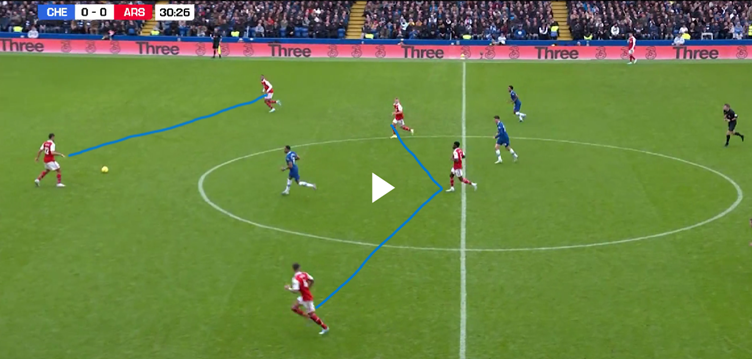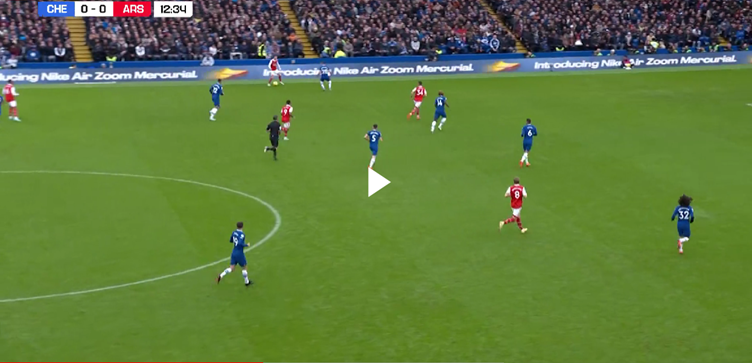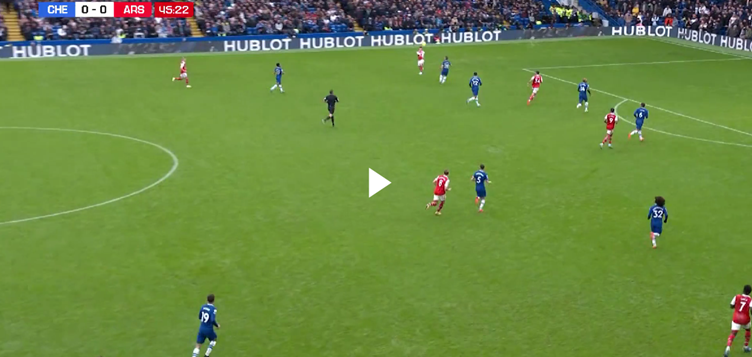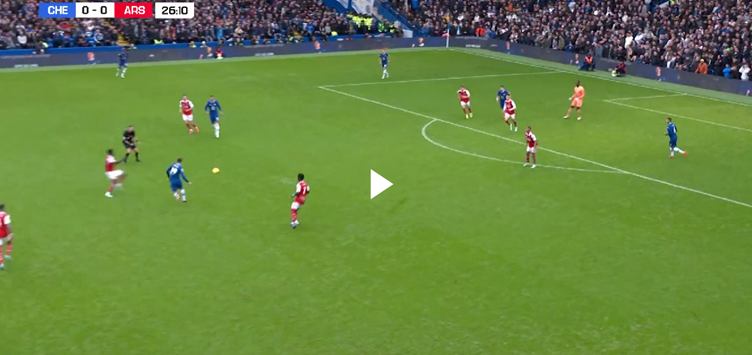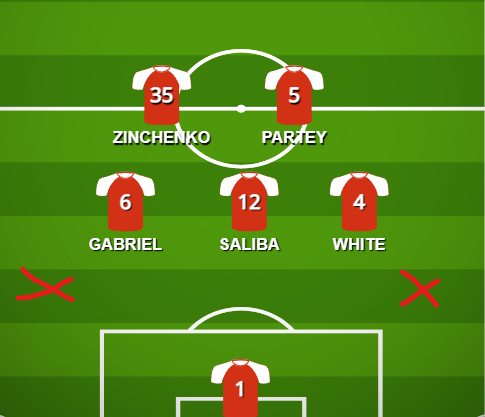During this season, I have written about the roles of a number of Arsenal’s players as Mikel Arteta’s tactical vision for the team has evolved. Some players are made by the system and some players make the system. In Zinchenko, Saliba and Gabriel Jesus, Arsenal have introduced three players into the starting line-up who have been able to transform the team’s style.
This column is going to be about Arsenal’s defensive shape overall, the consistency of which has literally given the team a solid platform on which to build. When we talk about team automatisms, we tend to focus on the attack because that’s the exciting part and it tends to be the more fluid part. The advantage of having a defined structure is that players can act quickly and instinctively under stress.
Before looking at the defence, let us first establish the attacking shape under Arteta. As with Pep Guardiola, they adopt a 2-3-5 or 3-2-5 shape, so much so that I no longer look at this team as playing in a 433 or a 4231, I simply look at it as 5-5. There are fluctuations within this structure but, largely, this is what Arsenal’s five attackers look like.
Players pop in and out of that shape all the time, Jesus rotates with Martinelli on occasion and Odegaard and Xhaka drop back to support the midfield shape. But this is the aim, to have those five attacking lanes filled and most of the time it is as you see it above. So what about the structure behind them?
I said I would do a little thread about Arsenal's rest defence from the Chelsea game today and I'm a man of my word…
— Jon Mackenzie (@Jon_Mackenzie) November 6, 2022
As I wrote last week, Arteta doesn’t want his full-backs to be supplementary attackers, their main job is not to overlap but to bolster the midfield. Odegaard and Xhaka are principally expected to be part of the five attacking lanes in possession, which requires a certain level of evacuation in midfield, a migration away from Thomas Partey. The job of the full-backs is to flank him and bolster that area.
Ben White might be pushed up next to Partey, making the back five structure a 2-3, or else he might be tucked in alongside Saliba, making it a 3-2. That will largely depend on game state and the opponent. At Selhurst Park in August, it was largely a 3-2 structure as White looked after Zaha, for example. Let’s look at a straightforward illustration from the Chelsea game on Sunday.
Here we see the 2-3 shape with Ben White running back to turn it into more of a 3-2. You can also see that Arsenal have a good numerical superiority with five players surrounding Chelsea’s attacking trio. This shape enables the team to keep the opposition under pressure, so even when they clear the ball away from their area, there is a block of five waiting to gobble the ball up and regurgitate it into a more advanced area. If you control space, you control the game.
With the full-backs as part of this block of five, the left-back, in particular, is not really asked to join the attack. Look when Arsenal attack on their left-hand side for example. As Arsenal build from the back, Gabriel Martinelli is pushed out to the flank where you might expect to see your left-back with Zinchenko inverted into midfield. Arteta doesn’t want a full-back overlapping Martinelli, this is why Kieran Tierney is currently not favoured.
When the ball is high and left for Arsenal, there isn’t a left-back overlapping, there is Granit Xhaka underlapping into the left inside channel. Here are two examples again, from the Chelsea game. The left-back, Zinchenko, is not at all interested in getting towards the penalty area in either of them. In the first one, he is not even in the shot.
Having five players behind the attack also enables one or two of the players to take a risk and engage opponents high up the pitch. Thomas Partey is a coiled spring in this respect, he often initiates the Gunners press by leaping out of his position to make interceptions high up the pitch and keep teams firmly under the grill. Again, just look at this example from Stamford Bridge as Mendy plays the ball out to Mason Mount.
Partey knows that even if he misjudges his attempt, he has four teammates behind him to back him up. If he wins it cleanly, there are five red shirts ahead of him. White, Saliba and Gabriel are all aggressive in engaging opposing attackers too. Tomiyasu, Zinchenko, White and Partey all average more than two tackles per game. In terms of tackles plus interceptions, Tomiyasu, Zinchenko, Partey and White all average more than three a game- these are high numbers.
Gabriel and Saliba do not feature quite as prominently in these statistics and that’s because their role is slightly different. No structure is entirely without its gaps. For Arsenal’s opponents, it is clear where the space is going to be if you can find the time and space to try to exploit it.
The space behind Zinchenko and White, the nominal full-backs, is the part of the pitch Arsenal leave open. This is partially a spatial gamble on Arteta’s part, if you are going to leave one area of your defence exposed, it is better to give up the wide areas as opposed to the central areas. But this is where the players make the system.
Gabriel and Saliba are trusted to recover into those spaces when opponents play the ball into them. White and Zinchenko are generally not miles up the pitch, they are just slightly inverted, meaning it’s a short run to come in and help their centre-halves out when opponents play into this space. Gabriel and Saliba’s job is either to run fast enough to sweep up the long passes (or for Ramsdale to leave his goalline and deal with them when necessary), or else jockey and hold their opponent long enough until the cavalry arrives.
To make attacking systems work, elite teams “over burden” certain players. Arsenal “over burden” Partey in the midfield space and they “over burden” the centre-halves by trusting them to cover large spaces in the advanced wide areas. There is no compromise in these positions, you need quality and you need the player attributes to make them work.
Liverpool spent years overburdening Virgil van Dijk so that Trent Alexander Arnold and Andy Robertson could play like wingers. In 2021-22, only Norwich City conceded more one-on-ones with their goalkeeper than Liverpool; but Klopp’s side knowingly left that risk in behind them because Alisson is so strong in those one-on-one situations.
Arteta prioritised building this defensive block, with Ramsdale, White, Tomiyasu all arriving in 2021, Saliba and Zinchenko in 2022 and Gabriel and Partey in 2020. The pricetag on each of these players raised eyebrows. Arteta understood that finessing this back five block was the key to making the front five block flourish. Saka, Xhaka and Martinelli were players he inherited, in that back five and goalkeeper, only Saliba was not signed by the current coach.
They may not look and behave like the famous back five of the George Graham years (not sure I could see Martin Keown sporting Ben White’s tattoos and earrings) but the intention is similar. The Invincibles back four of Lauren, Toure, Campbell and Cole were all capable of recovering into space and defending in isolated scenarios.
Elite teams need defensive blocks that a) behave like a structure but b) in times of high risk or when that structure is broken, can handle themselves in a knife fight. Really, good defending is about how you control space and the big teams need to leave a lot of it, by necessity. Arsenal have the defensive structure now to allow their attacking outlets to thrive.
Follow me on Twitter @Stillmanator– And like my page on Facebook



